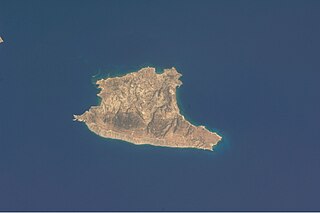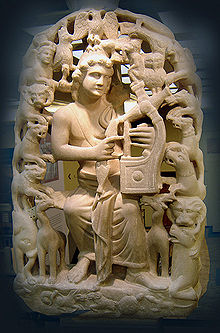
The Aegean Sea is an elongated embayment of the Mediterranean Sea located between the Greek and Anatolian peninsulas i.e. between the mainlands of Greece and Turkey. In the north, the Aegean is connected to the Marmara Sea and Black Sea by the Dardanelles and Bosphorus. The Aegean Islands are within the sea and some bound it on its southern periphery, including Crete and Rhodes.

Heraklion or Heraclion is the largest city and the administrative capital of the island of Crete. It is the fifth largest city in Greece. According to the results of the 2011 census, the population of the city proper was 140,730 inhabitants, the municipality's was 173,993 and it extends over an area of 684.3 km2 (264.2 sq mi).

The history of Crete goes back to the 7th millennium BC, preceding the ancient Minoan civilization by more than four millennia. The Minoan civilization was the first civilization in Europe and the first, in Europe, to build a palace.

The Pentozali or Pentozalis is the trademark folk dance of the island of Crete. It takes its name from the fifth (pente) attempt or step of Cretans to liberate Crete from Ottomans. The name can thus be translated as "five-steps". Also in the spirit of wordplay, ζάλη zali means dizziness, and the name of the dance can also be understood ("five-dizzy") as one that can make the dancers dizzy five times over. The dance has ten steps.

Gavdos is the southernmost Greek island, located to the south of its much larger neighbour, Crete, of which it is administratively a part, in the regional unit of Chania. It forms a community with surrounding islets and was part of the former Selino Province. The island is situated at the southern tip of Greece, thus making it the southernmost point of the entire European continent.

Ioannis Vlachos, better known as Daskalogiannis was a wealthy shipbuilder and shipowner who led a Cretan revolt against Ottoman rule in the 18th century.

The music of Crete, also called kritika, refers to traditional forms of Greek folk music prevalent on the island of Crete in Greece. Cretan traditional music includes instrumental music, a capella songs known as the rizitika, "Erotokritos," Cretan urban songs (tabachaniotika), as well as other miscellaneous songs and folk genres.

Sousta is the name of a folk dance in Cyprus and Crete which is danced in Greece and generally in the Balkans. The music is generally played with a lyre, laouto, and mandolin.

Greek folk music includes a variety of Greek styles played by ethnic Greeks in Greece, Cyprus, Australia, the United States and elsewhere. Apart from the common music found all-around Greece, there are distinct types of folk music, sometimes related to the history or simply the taste of the specific places.

Syrtos is, in classical and modern Greece: a folk dance in which the dancers link hands to form a chain or circle, headed by a leader who intermittently breaks away to perform improvised steps.

The Cretan State, was established in 1898, following the intervention by the Great Powers on the island of Crete. In 1897, an insurrection in Crete headed by the Ottoman Empire to declare war on Greece, which led Great Britain, France, Italy and Russia to intervene on the grounds that the Ottoman Empire could no longer maintain control. It was the prelude to the island's final annexation to the Kingdom of Greece, which occurred de facto in 1908 and de jure in 1913.

The Cretan lyra is a Greek pear-shaped, three-stringed bowed musical instrument, central to the traditional music of Crete and other islands in the Dodecanese and the Aegean Archipelago, in Greece. The Cretan lyra is considered to be the most popular surviving form of the medieval Byzantine lyra, an ancestor of most European bowed instruments.

Greece is a country in Southern Europe, bordered to the north by Albania, North Macedonia and Bulgaria; to the east by Turkey, and is surrounded to the east by the Aegean Sea, to the south by the Cretan and the Libyan Seas, and to the west by the Ionian Sea which separates Greece from Italy.
The hyporchema was a lively kind of mimic dance which accompanied the songs used in the worship of Apollo, especially among the Dorians. It was performed by men and women. It is comparable to the geranos (γερανός), the ritual "crane dance" associated with Theseus.

Gramvousa also Grampousa refers to two small uninhabited islands off the coast of a peninsula also known Gramvousa Peninsula in north-western Crete in the regional unit of Chania. The Gramvousa Peninsula forms the westernmost of the two pairs of peninsulae in north-western Crete and is the western part of Kissamos Bay.

Pidikhtos, is a Greek folk dance with Cretan origin, dancing in a circle formation. It is very widespread in Crete and the Greek islands.

Trizalis, is a Greek folk dance from Crete, Greece, similar to Pidikhtos and is very widespread in the Greek islands. It is also called "Κουρουθιανός" (Kourouthianos).
Ta Xila is a couples dance from Lesvos. The Xila is accompanied by the famous instrument the Santouri. The tune is a distinct tune on the island of Lesvos. The dance can be done as a syrto style dance in couple and in groups of four. The Xila is also popular at weddings and social gatherings on the island.












